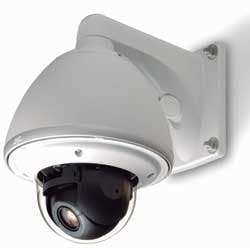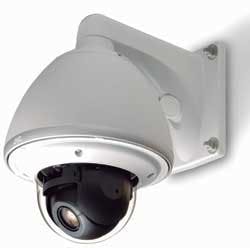Controlling IP CCTV network bandwidth
Bandwidth-hungry surveillance video running over an existing structured cabling network can result in ongoing organizational contention. Here's how to find a satisfying resolution for all concerned.
A new generation of IP (Internet Protocol) CCTV technology is appearing onLAN networks that allow several people to view security cameras through a simple click on a computer, or to access a camera that could be across the street or across the country. But as CCTV IP-based cameras—especially high-definition mega-pixel cameras—become more sophisticated, they also bring on new challenges to security and IT managers.
One of the biggest advantages of an IP-based CCTV system is the ability to use the existing data and voice structured cabling network infrastructure rather than separate coaxial cable. Previous proprietary analog systems over coax were kept separate from the data and voice network with their own horizontal and backbone system.
For IT managers, however, one of the biggest disadvantages of these evolving IP-based CCTV systems is utilizing network bandwidth. Running bandwidth-intensive surveillance video over corporate data networks is a point of on-going organizational contention.
Depending on the potential impact on the network performance, one solution is running an IP-based CCTV system on a parallel network, yet sharing the same backbone.
Paralell possibilities
A parallel network built to manage only the video infrastructure can isolate high-bandwidth video capturing and archiving without stealing precious bandwidth from other mission-critical applications. But, as video networks are merged on the same backbone and, therefore, require the expertise of IT professionals, the main concern is controlling that bandwidth—both through the transmission and at the storage end.
Video traffic differs from data and voice in that it is continuous. When sharing a network for dataapplications, bandwidth is usually consumed only when the user is moving the mouse around for anything and everything, from simpleword documents to storing and sending large graphical files. For VoIP, bandwidth is consumed only while "talking."
For video, there are three main fluctuating factors that contribute to bandwidth hogging of an IP camera—frame rate, resolution and compression. Any one of these factors can be throttled back to reduce the network bandwidth. For example, if you reduce the frame rate, you can increase the resolution, and vice versa.
Frames per second (FPS) describes the number of full video frames displayed or recorded within one second. Since each type of business varies, it is important to determine what requirements are needed to sustain certain defined performance parameters, such as frame rate.
Hollywood movies, for example, are shown at 24 frames per second—a rate based on how fast the human eye can detect change in a smooth transition. While most CCTV camerasystems can easily capture 30 or more frames per second(30 FPS is considered real time), the amount of videotape ordigital storage would be enormous to record everymoment of every day. But some industries, such as casi-nos (e.g., sleight of hand), require this kind of capacity.
Thirty FPS, however, has no relationship with motion picture quality. Power line frequency (60 Hz) is still used to synchronize our home TV with the broadcast station.Interlaced video systems and power line frequency is theorigin of 30 FPS in NTSC TV systems (one field for everycycle). In Europe, where power line frequency is 50 Hz, the TV frame rate is 25.
The purpose of a CCTV system is not to make Oscar-winning films but to catch a criminal act. Recording rates as low as one or two frames per second will catch virtually any criminal act. But, on an average, five to seven frames per second is the norm.
Resolution classifications
Investing in a good CCTV security system requires knowing the importance of high-resolution cameras. Resolution is the measurement of the camera's ability to reproduce detail. The quality level of video images, based on digital values, is expressed by TV lines (TVL), or pixels. The higher the number of pixels, the higher the resolution, and the better the video quality. High resolution, however, translates into greater file size and higher bandwidth requirements.
So, when talking about picture quality, you need to find out the purpose of the CCTV system and what needs to be captured on the IP camera. Three types of classifications will determine the resolution needed:
- Observation (is there someone present in the room?);
- Recognition (can you recognize this person?);
- Identification (can you see features that would clearly identify this person over another?).
Just like the frame rate, each installed CCTV system will take into account what it is trying to capture and why.
If the resolution needs to increase due to the application, bandwidth can be compensated by reducing the frame rate. For example, an IP camera running at 30 FPS and capturing an average of 320 x 240 pixels can capture the image at a higher resolution of 640 x 480 pixels by lowering the frame rate to 7.5 FPS. These two scenarios will use the same amount of network bandwidth and can be stored in the same amount of storage (HDD) space.
JPEG, MPEG, oh my
Compression is the technique that reduces the quantity of digital data (or pixels) used to represent video images andarranges them into a more compact file size to transfer and to store on your hard drive. An uncompressed picture may have the highest image quality, but takes up a considerable amount of space on the storage devices. The truth is that the greater the compression, the more a picture can degrade, but the less bandwidth and data storage it utilizes.
The many different techniques of compression algorithms can be overwhelming, but basically, there are two mainstream types—JPEG and MPEG4. Lately, a few camera manufacturers have deployed the H.264 compression, and although this compression algorithm can produce a smaller file size, it is not quite ready for security applications.
JPEG takes the entire image, compresses it and then records it. MPEG4 uses temporal compression and compares image-to-image, and only records the changes in the images. If there are very little changes between subsequent frames, then very little storage space is consumed. For example, if a personwalks into a room, only the person will be recorded,as the background would automatically transition fromframe to frame. On the other hand, if recording a busy moving highway, changes occur with every frame that wouldrequire increased data transfer and storage.
To control the bandwidth for both video transfer andstorage, your choices are to reduce your picture size (or resolution), reduce the number of pictures recorded/views persecond (frame rate), or live with an over-compresseddegraded image.
Calculating the bandwidth
Let's take a look at how to calculate the bandwidth of a single frame and disk space needed for recording and storage. The first step is to find out the file size of a single image. For example, let's use a file that is 30 kilobytes (KB), which is also 30,000 bytes (B) per frame—the typical size of a VGA file at a medium JPEG compression. Note that transport bandwidth is stated in bits and disc storage is represented in bytes. The two are not interchangeable, as one Byte (B) is equal to eight bits (b).
To convert the 30 KB file to bits, multiplying by a factor of eight will total 240 kilobits (Kb) (or 240,000 bits) of network bandwidth per frame. If using a maximum frame rate of30 FPS, multiply that one frame by 30, and the product is7,200 kilobits, or 7.2 megabits (Mb). This is how muchbandwidth is necessary to send that one second of video.
For calculating data storage bandwidth, the image bandwidth of 7.2 Mb needs to be converted back to bytes and will, therefore, be divided by a factor of eight (bits to Bytes) to equal 0.9 MB.
To determine how this translates into the amount of storage per hour required, the figure needs to be multiplied by 3,600 (seconds in an hour). When multiplying 0.9 MB by3,600, the total is 3,240 MB per hour needed for storage ofthat file. Multiply that by 24 (hours in a day) and that oneframe will take up 77,760 MB of storage per day.
This is only one frame and one camera! You can imagine how this will add up with multiple cameras and why IT managers are concerned about the network.
Online tools are available to help you figure out how to use mitigation techniques, such as reducing the frame rate, resolution, and selecting a lower compression rate. You can download one such tool, a bandwidth calculator—"IPCamera Calc. JPEG.xls"—from the JVC Professional Products, Security FTP site (ftp://206.229.18.130/). This tool lets you select the filetype, compression, and frame rate, providing the amount of bandwidth needed in days, months, and years for bothtransmission and disk space utilization.
Assuring reliability
When working with customers on specifying IP systems, it is important to determine security equipment requirements along with the network required to sustain video-defined performance parameters. For example, the type of camera you choose will be the basis for determining the needed bandwidth and data storage. And the type of camera you select will affect the type of structured cabling to be specified. If you select a mega-pixel camera environment, make sure you are installing a big enough "pipe" for the bandwidth to travel down.
Whether you need to simply observe an event or need to identify and analyze, the type of camera you select will make all the difference. Keep in mind, what the end user sees is the picture provided by the camera. Select a camera from areputable manufacturer that can provide you with the mostfeatures for your application, along with an excellentwarranty.
When shopping for IP cameras, make sure to compare picture quality, low-light operation, motion picture, reliability, impact on network performance and warranty. Be aware of incomplete specifications!
Cable selection and bandwidth go hand-in-hand. Considerations when selecting the cable media include number of cameras, type of camera, location of the cameras (environment), distance to the telecom rooms, type of termination equipment, and whether power will be running through the cable (UTP).
A Category 5e cable may be sufficient with its allowable1 Gbit/sec data rate (depending on the protocol). But Category 6 operates at a higher data rate (up to 10 Gbits/sec), and because of its improved transmission performance and superior immunity from external noise, systems operating over Category 6 cabling will have fewer errors versus Category 5e for current applications. This means fewer re-transmissions of lost or corrupted data packets under certain conditions, which translates into higher reliability for Category 6 networks.Also, when inducing noise or heat (such as in Power over Ethernet), Category 6 has been proven to operate with a lower rate of dropped packets (or frames).
Bringing it all into focus
IP cameras offer new and expanded features in CCTV surveillance, such as analytic capabilities and notification alerts not previously possible with analog systems. But this technology can suffer from insufficient performance and scalability because of poor system architecture and poor product selection.
To realize the full benefits of IP video surveillance, it's important to design and build a system that is capable of per-forming to current and future requirements, which includes allocating sufficient bandwidth to video-carrying traffic so that it will not congest the network. IT managers and security|integrators need to learn to intelligently select and manage all resources.
CAROL EVERETT OLIVER, RCDD, is marketing analyst for Berk-Tek (www.berk-tek), and has been involved in driving the NetClear ESS security initiative, which focuses on use of a structured cabling system for analog, hybrid and IP CCTV scenarios. ADRIAN PARVULESCU is engineering manager for JVC Professional Products Company and heads up engineering for the security division at JVC Corp. (www.jvc.com). He holds various design patents, including the wireless voice message system and 360° video processing.


